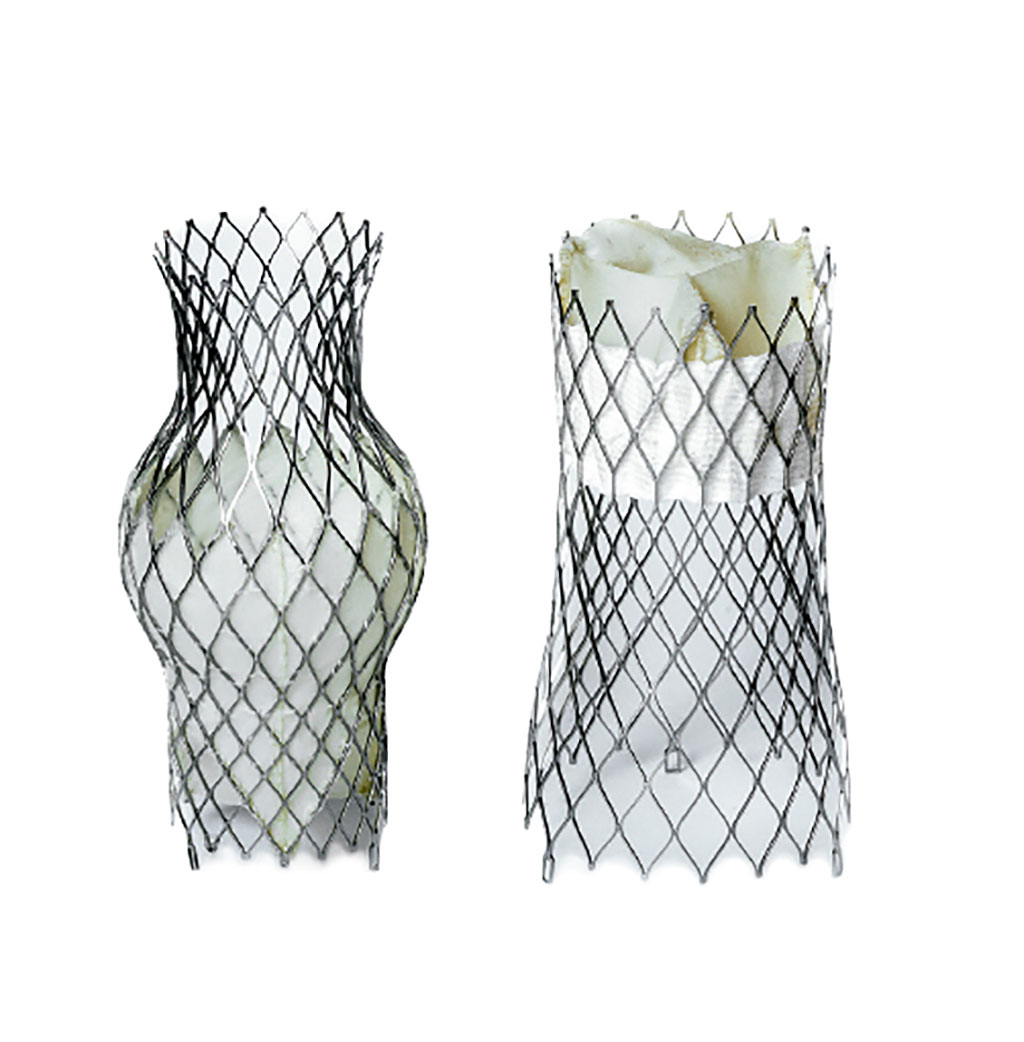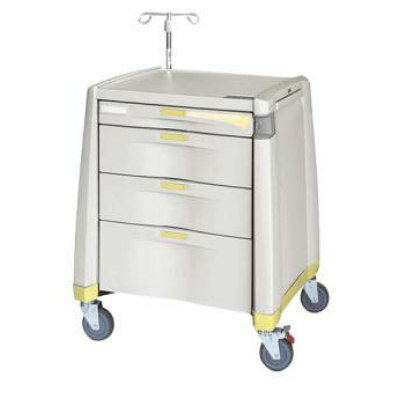Minimally Invasive Valves System Alleviates Severe Tricuspid Insufficiency 
|
By HospiMedica International staff writers Posted on 09 Jun 2021 |

Image: The superior (L) and inferior (R) vena cava TricValve Transcatheter Bicval valves (Photo courtesy of P+F Products + Features)
A new transcatheter bioprosthesis help those suffering from caval reflux resulting from severe tricuspid regurgitation, without removal of the defective tricuspid valve.
The P&F (Vienna, Austria) TricValve Transcatheter Bicaval Valves System consists of two self-expanding biological valves that are implanted via a percutaneous procedure simultaneously into both the superior and inferior vena cava, and without disturbing the native tricuspid valve. The bioprosthesis valves are available in different diameters, one for the superior vena cava (SVC) and one inferior vena each cava (IVC). The valves, made of bovine pericardium, come fully pre-mounted, facilitating the use of the system in clinical practice.
The SVC valve is available in sizes of 25 mm and 29 mm; the 25 mm valve encompasses a treatment range of 22-31 mm, and the 29 mm valve is intended for veins 27-34 mm in diameter. Nitinol frame heights are 67 and 69 mm respectively in a relaxed state, with a long polyethylene terephthalate (PET) skirt to prevent para valvular leak (PVL). The IVC valve is available is 31 mm and 35 mm diameters; the treatment ranges are 24-31 mm and 28-35 mm, respectively. Frame height in both IVC valves is 65 mm, including a short PET skirt to prevent hepatic vein occlusion.
“TricValve provides a new treatment option for patients that are not suitable for surgery, as well as patients with very dilated annulus or very large coaptation gap, or even with a pacemaker,” said Shaiful Azmi Yahaya, MD, head of the cardiology department at the National Heart Institute (Kuala Lumpur, Malaysia).
The tricuspid valve separates the right atrium of the heart from the right ventricle, preventing blood from flowing from the ventricle back into the atrium. Diseases of the tricuspid valve are much rarer than those of the mitral valve, its counterpart in the left half of the heart. Tricuspid insufficiency leads to the build-up of blood in the ventricle and the veins causes increased pressure on these organs, resulting in water retention in the legs and abdomen, liver damage, and potential atrial fibrillation (AF).
Related Links:
P&F
The P&F (Vienna, Austria) TricValve Transcatheter Bicaval Valves System consists of two self-expanding biological valves that are implanted via a percutaneous procedure simultaneously into both the superior and inferior vena cava, and without disturbing the native tricuspid valve. The bioprosthesis valves are available in different diameters, one for the superior vena cava (SVC) and one inferior vena each cava (IVC). The valves, made of bovine pericardium, come fully pre-mounted, facilitating the use of the system in clinical practice.
The SVC valve is available in sizes of 25 mm and 29 mm; the 25 mm valve encompasses a treatment range of 22-31 mm, and the 29 mm valve is intended for veins 27-34 mm in diameter. Nitinol frame heights are 67 and 69 mm respectively in a relaxed state, with a long polyethylene terephthalate (PET) skirt to prevent para valvular leak (PVL). The IVC valve is available is 31 mm and 35 mm diameters; the treatment ranges are 24-31 mm and 28-35 mm, respectively. Frame height in both IVC valves is 65 mm, including a short PET skirt to prevent hepatic vein occlusion.
“TricValve provides a new treatment option for patients that are not suitable for surgery, as well as patients with very dilated annulus or very large coaptation gap, or even with a pacemaker,” said Shaiful Azmi Yahaya, MD, head of the cardiology department at the National Heart Institute (Kuala Lumpur, Malaysia).
The tricuspid valve separates the right atrium of the heart from the right ventricle, preventing blood from flowing from the ventricle back into the atrium. Diseases of the tricuspid valve are much rarer than those of the mitral valve, its counterpart in the left half of the heart. Tricuspid insufficiency leads to the build-up of blood in the ventricle and the veins causes increased pressure on these organs, resulting in water retention in the legs and abdomen, liver damage, and potential atrial fibrillation (AF).
Related Links:
P&F
Latest Surgical Techniques News
- Robotic Assistant Delivers Ultra-Precision Injections with Rapid Setup Times
- Minimally Invasive Endoscopic Surgery Improves Severe Stroke Outcomes
- Novel Glue Prevents Complications After Breast Cancer Surgery
- Breakthrough Brain Implant Enables Safer and More Precise Drug Delivery
- Bioadhesive Sponge Stops Uncontrolled Internal Bleeding During Surgery
- Revolutionary Nano Bone Material to Accelerate Surgery and Healing
- Superior Orthopedic Implants Combat Infections and Quicken Healing After Surgery
- Laser-Based Technique Eliminates Pancreatic Tumors While Protecting Healthy Tissue
- Surgical Treatment of Severe Carotid Artery Stenosis Benefits Blood-Brain Barrier
- Revolutionary Reusable Duodenoscope Introduces 68-Minute Sterilization
- World's First Transcatheter Smart Implant Monitors and Treats Congestion in Heart Failure
- Hybrid Endoscope Marks Breakthrough in Surgical Visualization
- Robot-Assisted Bronchoscope Diagnoses Tiniest and Hardest to Reach Lung Tumors
- Diamond-Titanium Device Paves Way for Smart Implants that Warn of Disease Progression
- 3D Printable Bio-Active Glass Could Serve as Bone Replacement Material
- Spider-Inspired Magnetic Soft Robots to Perform Minimally Invasive GI Tract Procedures
Channels
Critical Care
view channel
Light-Based Technology to Measure Brain Blood Flow Could Diagnose Stroke and TBI
Monitoring blood flow in the brain is crucial for diagnosing and treating neurological conditions such as stroke, traumatic brain injury (TBI), and vascular dementia. However, current imaging methods like... Read more
AI Heart Attack Risk Assessment Tool Outperforms Existing Methods
For decades, doctors have relied on standardized scoring systems to assess patients with the most common type of heart attack—non-ST-elevation acute coronary syndrome (NSTE-ACS). The GRACE score, used... Read morePatient Care
view channel
Revolutionary Automatic IV-Line Flushing Device to Enhance Infusion Care
More than 80% of in-hospital patients receive intravenous (IV) therapy. Every dose of IV medicine delivered in a small volume (<250 mL) infusion bag should be followed by subsequent flushing to ensure... Read more
VR Training Tool Combats Contamination of Portable Medical Equipment
Healthcare-associated infections (HAIs) impact one in every 31 patients, cause nearly 100,000 deaths each year, and cost USD 28.4 billion in direct medical expenses. Notably, up to 75% of these infections... Read more
Portable Biosensor Platform to Reduce Hospital-Acquired Infections
Approximately 4 million patients in the European Union acquire healthcare-associated infections (HAIs) or nosocomial infections each year, with around 37,000 deaths directly resulting from these infections,... Read moreFirst-Of-Its-Kind Portable Germicidal Light Technology Disinfects High-Touch Clinical Surfaces in Seconds
Reducing healthcare-acquired infections (HAIs) remains a pressing issue within global healthcare systems. In the United States alone, 1.7 million patients contract HAIs annually, leading to approximately... Read moreHealth IT
view channel
Printable Molecule-Selective Nanoparticles Enable Mass Production of Wearable Biosensors
The future of medicine is likely to focus on the personalization of healthcare—understanding exactly what an individual requires and delivering the appropriate combination of nutrients, metabolites, and... Read moreBusiness
view channel
Philips and Masimo Partner to Advance Patient Monitoring Measurement Technologies
Royal Philips (Amsterdam, Netherlands) and Masimo (Irvine, California, USA) have renewed their multi-year strategic collaboration, combining Philips’ expertise in patient monitoring with Masimo’s noninvasive... Read more
B. Braun Acquires Digital Microsurgery Company True Digital Surgery
The high-end microsurgery market in neurosurgery, spine, and ENT is undergoing a significant transformation. Traditional analog microscopes are giving way to digital exoscopes, which provide improved visualization,... Read more
CMEF 2025 to Promote Holistic and High-Quality Development of Medical and Health Industry
The 92nd China International Medical Equipment Fair (CMEF 2025) Autumn Exhibition is scheduled to be held from September 26 to 29 at the China Import and Export Fair Complex (Canton Fair Complex) in Guangzhou.... Read more














